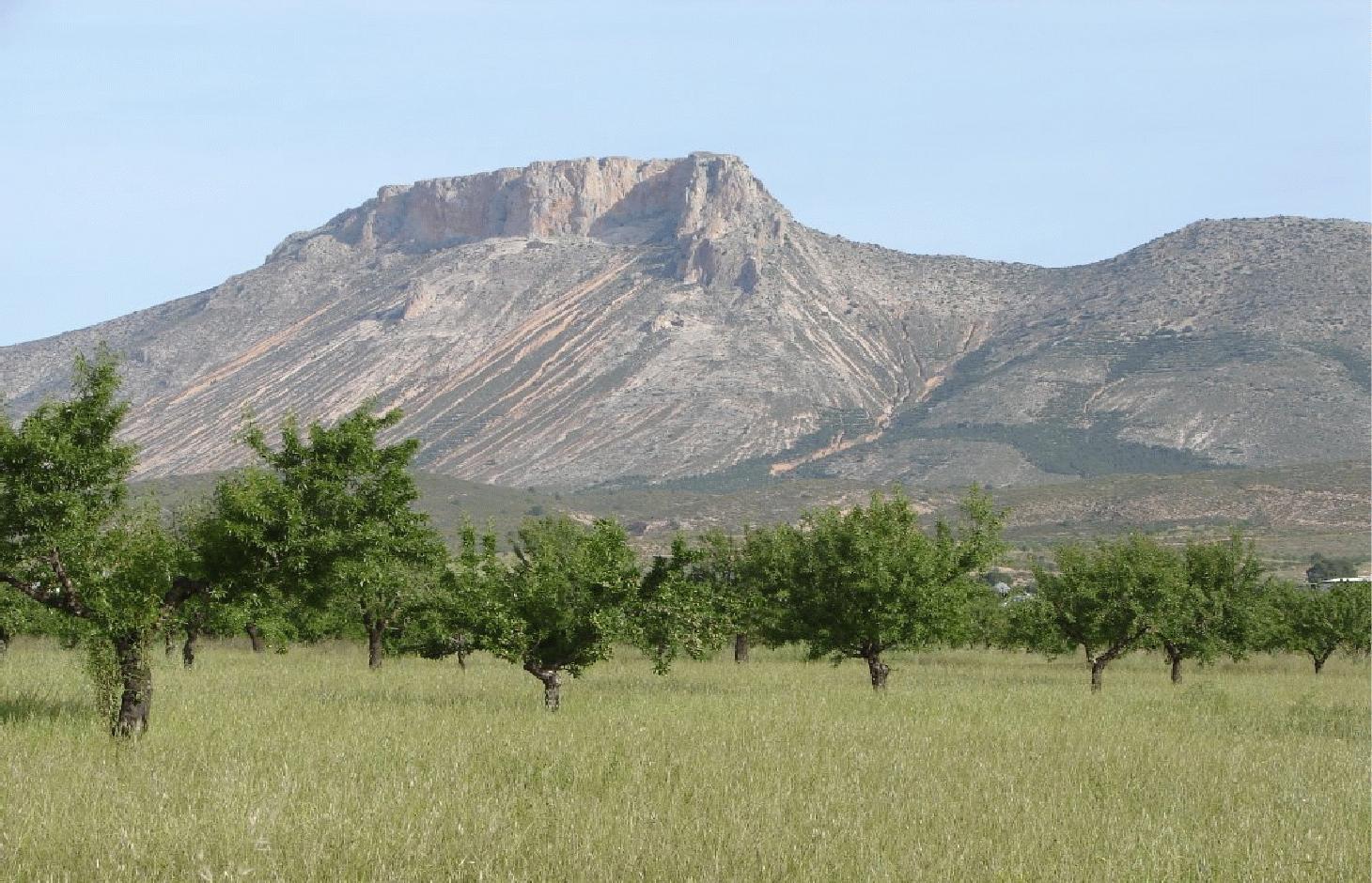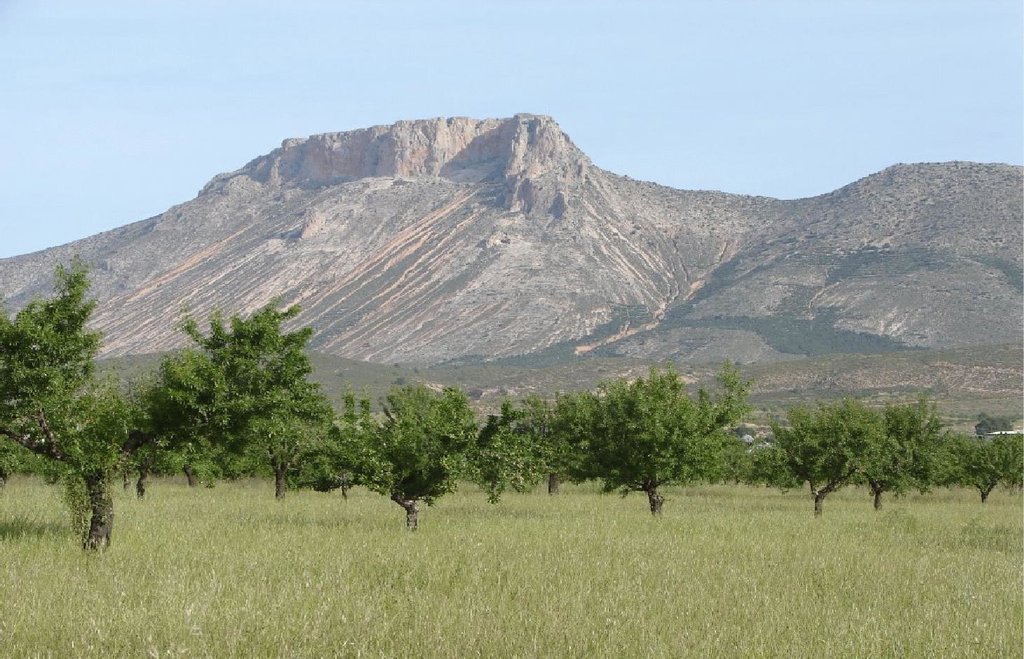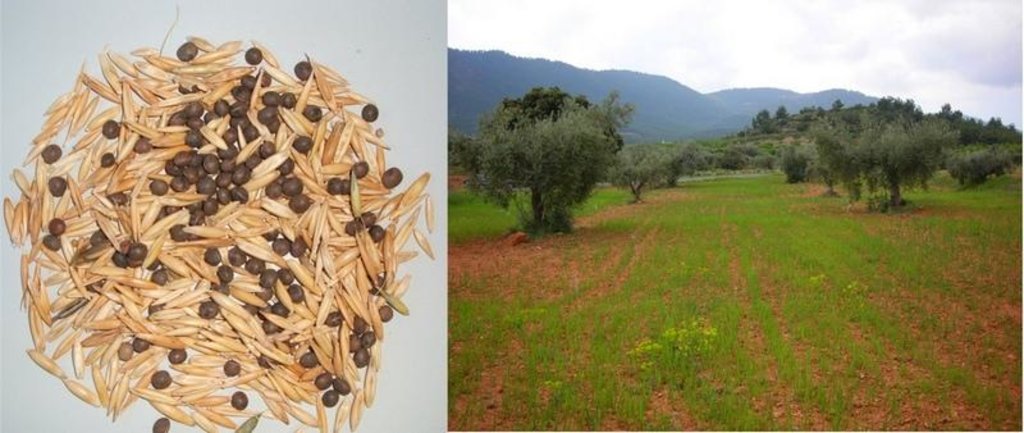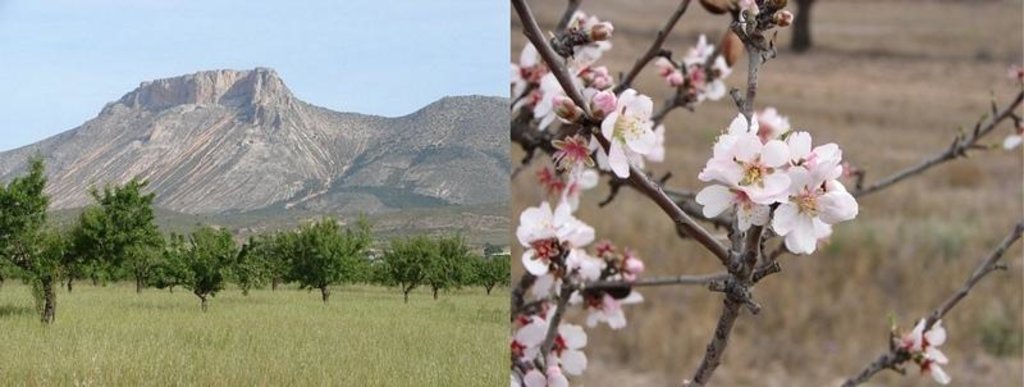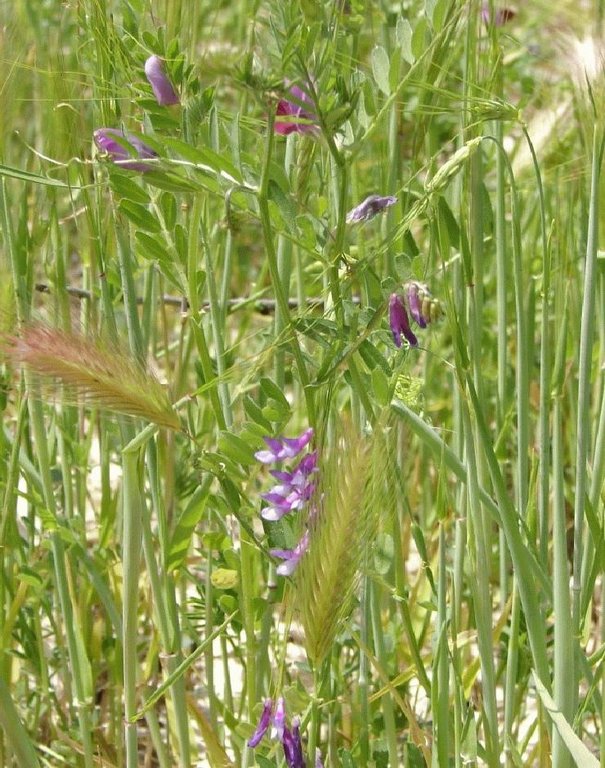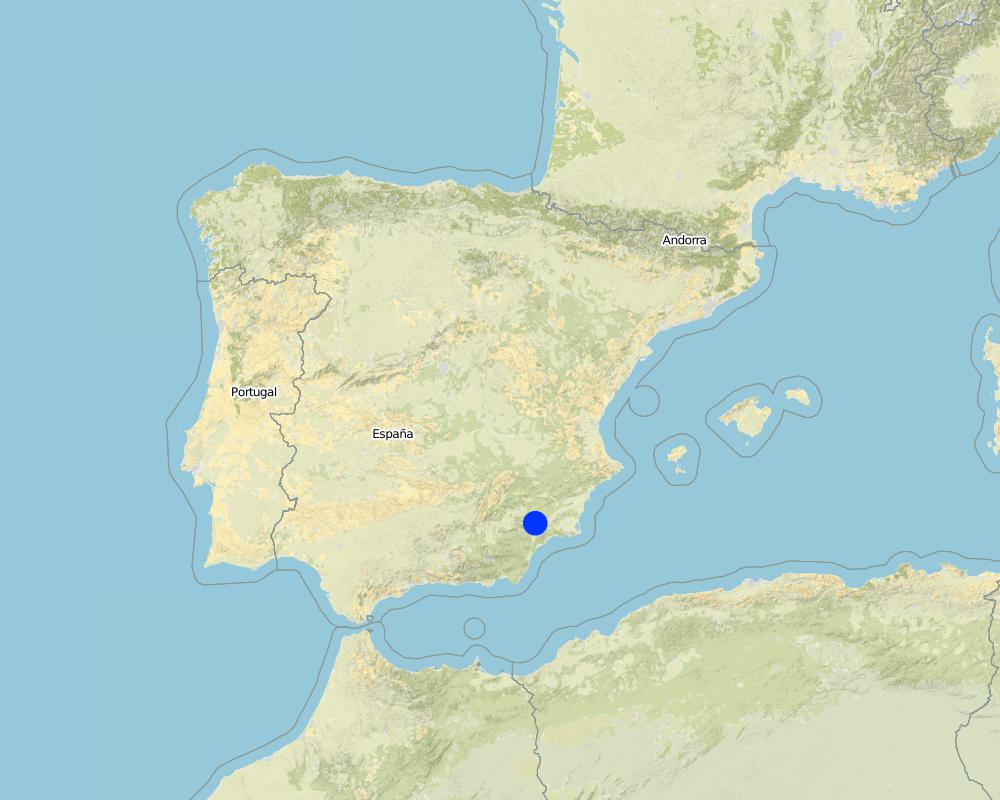Ecological production of almonds and olives using green manure [Spain]
- Creation:
- Update:
- Compiler: Joris De Vente
- Editor: –
- Reviewers: Fabian Ottiger, Deborah Niggli, Alexandra Gavilano
Agricultura ecológica de almendros y olivos (Spanish)
technologies_1019 - Spain
View sections
Expand all Collapse all1. General information
1.2 Contact details of resource persons and institutions involved in the assessment and documentation of the Technology
SLM specialist:
SLM specialist:
López Carratala Jorge
Consejo Superior de Investigaciones Científicas, Estación Experimental de Zonas Áridas (EEZA-CSIC)
Spain
SLM specialist:
Ibáñez Torres Ascensión
Consejería de Agricultura y Agua Murcia (CARM)
Spain
land user:
Escamez Antonio
Spain
Inspector for ecological agriculture :
López Ros Elias
Spain
Responsible technician of ALIMER agricultural cooperation:
Lopez Pedro
ALIMER
Spain
Technical agronomic engineer :
Cervantes Pujante Celestino
COATO S.Coop
Spain
SLM specialist:
Martinez-Mena Maria
CEBAS-CSIC.
Spain
Name of project which facilitated the documentation/ evaluation of the Technology (if relevant)
DESIRE (EU-DES!RE)Name of the institution(s) which facilitated the documentation/ evaluation of the Technology (if relevant)
EEZA-CSIC (EEZA-CSIC) - SpainName of the institution(s) which facilitated the documentation/ evaluation of the Technology (if relevant)
Consejería de Agricultura y Agua Murcia (CARM) - SpainName of the institution(s) which facilitated the documentation/ evaluation of the Technology (if relevant)
Alimentos del mediterráneo (ALIMER) - SpainName of the institution(s) which facilitated the documentation/ evaluation of the Technology (if relevant)
COATO - SpainName of the institution(s) which facilitated the documentation/ evaluation of the Technology (if relevant)
Centro de Edafología y Biología Aplicada del Segura (CEBAC-CSIC) - Spain1.3 Conditions regarding the use of data documented through WOCAT
The compiler and key resource person(s) accept the conditions regarding the use of data documented through WOCAT:
Ja
1.5 Reference to Questionnaire(s) on SLM Approaches (documented using WOCAT)
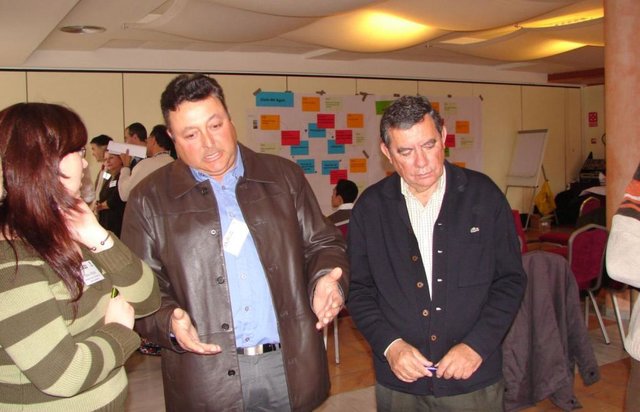
Regional rural development programme [Spain]
Regional development programme to protect natural resources and stimulate rural economies.
- Compiler: Joris De Vente
2. Description of the SLM Technology
2.1 Short description of the Technology
Definition of the Technology:
Ecological production of almonds and olives under dryland conditions using green manure to increase soil fertility, to protect against soil erosion and to obtain a high-value product.
2.2 Detailed description of the Technology
Description:
Ecological agriculture is a strictly controlled production system that does not use synthetic chemical products like fertilizers, insecticides or pesticides. Also genetically modified organisms and materials are not used. Green manure or low quantities of organic fertilizers, preferably from dung (sheep, goat, cow, chicken), are used to increase and maintain soil fertility. Green manure is provided by seeding a mixture of leguminous nitrogen-fixing species and cereals in autumn (October) and incorporating this into the soil with tillage in springtime (May). To optimize the fertilizer effect, there is still scientific discussion on the need for mowing the green manure and letting it dry for several days before it is ploughed into the soil. For this system, no ploughing is performed in winter, which reduces fuel use and emission of greenhouse gases. In addition to its fertilising effect, green manure provides a continuous surface cover during winter time protecting the soil from erosion. The products grown under this ecological system command a higher market price than those grown under conventional production schemes.
Purpose of the Technology: The aim of ecological agriculture is to protect biodiversity and the environment and maintain or improve soil fertility and reduce soil, water, and air pollution. Under ecological agriculture and by using green manure, soil cover, soil organic matter, and soil biological activity will increase, which positively affects soil structure, soil fertility and soil water infiltration capacity. This reduces the sensitivity of the soil to surface crusting and it reduces surface runoff and soil erosion by up to 60%. Workload and energy use are up to 50% lower than under conventional agriculture, and benefits may increase around 40% due to higher yields. Moreover, a higher market price of ecologically produced almonds and olives will lead to increased farm income. This better economic return discourages land abandonment of marginal lands with low productivities under conventional farming. Ecological almonds and olives production does not require special establishment activities or investments in specialized equipment.
Establishment / maintenance activities and inputs: Infestations by, for example, insects and caterpillars are treated twice yearly by degradable products based on copper salts (Oxicloruro, max 3‰ solution) and mineral oils in winter, or the spores and proteins produced by the bacteria Bacillus thuringiensis or based on natural pyrethrins (from the Chrysanthemum cinerariaefolium; max 1.5 l/ha) in springtime. In ecological agriculture, farmers are obliged to take advice and instructions regarding plague control and fertilizer use from technicians specialized in ecological agriculture.
Natural / human environment: Soils mostly have a shallow to medium depth (between 20-60 cm), and slopes are gentle to moderate (between 5 and 15%). The climate is semi-arid with a mean annual rainfall around 300 mm. Droughts, in summer, commonly last for more than 4-5 months. Annual potential evapotranspiration rates larger than 1000 mm are common. The production system is highly mechanised and market-oriented but depends strongly on agricultural subsidies. All cropland is privately owned.
2.3 Photos of the Technology
2.5 Country/ region/ locations where the Technology has been applied and which are covered by this assessment
Country:
Spain
Region/ State/ Province:
Murcia
Further specification of location:
Guadalentin catchment
Specify the spread of the Technology:
- evenly spread over an area
If precise area is not known, indicate approximate area covered:
- 10-100 km2
Map
×2.6 Date of implementation
If precise year is not known, indicate approximate date:
- less than 10 years ago (recently)
2.7 Introduction of the Technology
Specify how the Technology was introduced:
- through projects/ external interventions
Comments (type of project, etc.):
Ecological agriculture is strongly stimulated by regional government through subsidies in last 8 years.
3. Classification of the SLM Technology
3.2 Current land use type(s) where the Technology is applied

Cropland
- Tree and shrub cropping
Number of growing seasons per year:
- 1
Specify:
Longest growing period in days: 220Longest growing period from month to month: Nov - Jun
Comments:
Major land use problems (compiler’s opinion): A lack of water availability seriously limits the production potential of the soil and results in a low vegetation/crop cover. The relatively high soil erosion rates cause various off-site related problems (i.e. flooding, reservoir siltation) and on-site problems (i.e. gully formation and reduced soil depth).
Major land use problems (land users’ perception): There is a lack of water for irrigation of crops limiting the crop types that can be planted as well as the crop yield of dryland farming.
Livestock is grazing on crop residues
3.4 Water supply
Water supply for the land on which the Technology is applied:
- rainfed
3.5 SLM group to which the Technology belongs
- integrated soil fertility management
3.6 SLM measures comprising the Technology

agronomic measures
- A2: Organic matter/ soil fertility

management measures
- M6: Waste management (recycling, re-use or reduce)
Comments:
Main measures: agronomic measures
Secondary measures: management measures
Type of agronomic measures: green manure
3.7 Main types of land degradation addressed by the Technology

soil erosion by water
- Wt: loss of topsoil/ surface erosion
- Wo: offsite degradation effects

chemical soil deterioration
- Cn: fertility decline and reduced organic matter content (not caused by erosion)
- Cp: soil pollution

biological degradation
- Bl: loss of soil life
- Bp: increase of pests/ diseases, loss of predators

water degradation
- Hp: decline of surface water quality
- Hq: decline of groundwater quality
Comments:
Main type of degradation addressed: Wo: offsite degradation effects, Cp: soil pollution, Hq: decline of groundwater quality
Secondary types of degradation addressed: Wt: loss of topsoil / surface erosion, Cn: fertility decline and reduced organic matter content, Bl: loss of soil life, Bp: increase of pests / diseases, loss of predators, Hp: decline of surface water quality
Main causes of degradation: soil management (Excessive use of pesticides and herbicides), crop management (annual, perennial, tree/shrub) (Excessive use of pesticides and herbicides), education, access to knowledge and support services (lack of knowledge of off site effects for contamination)
3.8 Prevention, reduction, or restoration of land degradation
Specify the goal of the Technology with regard to land degradation:
- prevent land degradation
- reduce land degradation
Comments:
Main goals: prevention of land degradation, mitigation / reduction of land degradation
4. Technical specifications, implementation activities, inputs, and costs
4.1 Technical drawing of the Technology
Technical specifications (related to technical drawing):
Mixture of barley and vetch (Vicia sativa) seeds used for seeding green manure.
Technical knowledge required for field staff / advisors: high (High level of knowledge of possibilities and limitations of fertilizer use and plague control is needed.)
Technical knowledge required for land users: moderate (Moderate level of knowledge of fertilizer use and plague control.)
Main technical functions: control of dispersed runoff: retain / trap, control of dispersed runoff: impede / retard, improvement of ground cover, increase in nutrient availability (supply, recycling,…)
Secondary technical functions: improvement of surface structure (crusting, sealing), improvement of topsoil structure (compaction), improvement of subsoil structure (hardpan), increase in organic matter, increase of infiltration, increase / maintain water stored in soil, improvement of water quality, buffering / filtering water
Green manure
Material/ species: seed
Quantity/ density: 195 kg/ha
Remarks: Mixture of Vicia (65kg) and Avena (130kg)
Other type of management: Ecological farming: Absence of chemical fertilizers, pesticides and herbicides
Author:
Joris de Vente
4.2 General information regarding the calculation of inputs and costs
other/ national currency (specify):
EURO
If relevant, indicate exchange rate from USD to local currency (e.g. 1 USD = 79.9 Brazilian Real): 1 USD =:
0.63
Indicate average wage cost of hired labour per day:
79.00
4.4 Costs and inputs needed for establishment
Comments:
Duration of establishment phase: 1 month(s)
4.5 Maintenance/ recurrent activities
| Activity | Timing/ frequency | |
|---|---|---|
| 1. | seeding green manure | autumn (October) |
| 2. | ploughing green manure | spring (May) |
| 3. | organic fertilizer of cow dung (optional) | spring |
| 4. | ecological treatment against plagues days | winter and april |
4.6 Costs and inputs needed for maintenance/ recurrent activities (per year)
| Specify input | Unit | Quantity | Costs per Unit | Total costs per input | % of costs borne by land users | |
|---|---|---|---|---|---|---|
| Labour | Labour | ha | 1.0 | 25.0 | 25.0 | 37.0 |
| Equipment | Machine use | ha | 1.0 | 72.0 | 72.0 | 37.0 |
| Plant material | Seeds | ha | 1.0 | 96.0 | 96.0 | 37.0 |
| Fertilizers and biocides | Fertilizer | ha | 1.0 | 79.0 | 79.0 | 37.0 |
| Fertilizers and biocides | Biocides | ha | 1.0 | 159.0 | 159.0 | 37.0 |
| Total costs for maintenance of the Technology | 431.0 | |||||
| Total costs for maintenance of the Technology in USD | 684.13 | |||||
Comments:
Machinery/ tools: tractor with seeding machinery, tractor
Cow dung costs approximately US $350 per tonne and will therefore increase the costs significantly if applied. The costs are calculated assuming the application of green manure, ecological pesticides and organic fertilizer. However, many farmers decide not to use organic fertilizer because of their high costs. As part of the Rural Development Programme (QASPA01), ecological agriculture receives a subsidy of 476 US $ per ha during the first 3 years of production, after which the subsidy is reduced to 380 US $ per ha. Prices are for spring 2008.
4.7 Most important factors affecting the costs
Describe the most determinate factors affecting the costs:
Fuel price, ecological pesticides and organic fertilizer are the most determining factors affecting the costs.
5. Natural and human environment
5.1 Climate
Annual rainfall
- < 250 mm
- 251-500 mm
- 501-750 mm
- 751-1,000 mm
- 1,001-1,500 mm
- 1,501-2,000 mm
- 2,001-3,000 mm
- 3,001-4,000 mm
- > 4,000 mm
Specifications/ comments on rainfall:
Dry period in summer during 3-4 months (June – August/September)
Agro-climatic zone
- semi-arid
Thermal climate class: subtropics
Thermal climate class: temperate. The higher parts are generally somewhat colder
5.2 Topography
Slopes on average:
- flat (0-2%)
- gentle (3-5%)
- moderate (6-10%)
- rolling (11-15%)
- hilly (16-30%)
- steep (31-60%)
- very steep (>60%)
Landforms:
- plateau/plains
- ridges
- mountain slopes
- hill slopes
- footslopes
- valley floors
Altitudinal zone:
- 0-100 m a.s.l.
- 101-500 m a.s.l.
- 501-1,000 m a.s.l.
- 1,001-1,500 m a.s.l.
- 1,501-2,000 m a.s.l.
- 2,001-2,500 m a.s.l.
- 2,501-3,000 m a.s.l.
- 3,001-4,000 m a.s.l.
- > 4,000 m a.s.l.
Indicate if the Technology is specifically applied in:
- not relevant
Comments and further specifications on topography:
Landforms: plateau / plains, hill slopes, footslopes, valley floors
5.3 Soils
Soil depth on average:
- very shallow (0-20 cm)
- shallow (21-50 cm)
- moderately deep (51-80 cm)
- deep (81-120 cm)
- very deep (> 120 cm)
Soil texture (topsoil):
- medium (loamy, silty)
- fine/ heavy (clay)
Topsoil organic matter:
- medium (1-3%)
- low (<1%)
If available, attach full soil description or specify the available information, e.g. soil type, soil PH/ acidity, Cation Exchange Capacity, nitrogen, salinity etc.
Soil fertility is low
Soil drainage/infiltration is poor/none
Soil water storage capacity is medium
5.4 Water availability and quality
Ground water table:
5-50 m
Availability of surface water:
poor/ none
Water quality (untreated):
for agricultural use only (irrigation)
Comments and further specifications on water quality and quantity:
Ground water table: >50m (there is a lowering of groundwater table due to overexploitation for irrigation purposes)
Availability of surface water:S Poor/none. Sporadically there are flash floods during extreme rainfall events
Water quality (untreated): For agricultural use only (irrigation) (groundwater from aquifers)
5.5 Biodiversity
Species diversity:
- low
5.6 Characteristics of land users applying the Technology
Market orientation of production system:
- mixed (subsistence/ commercial)
- commercial/ market
Off-farm income:
- > 50% of all income
Relative level of wealth:
- average
Individuals or groups:
- cooperative
Level of mechanization:
- mechanized/ motorized
Gender:
- men
Indicate other relevant characteristics of the land users:
Land users applying the Technology are mainly common / average land users
Difference in the involvement of women and men: Traditionally most agriculture is done by men in this region.
Population density: 10-50 persons/km2
Annual population growth: 3% - 4%
15% of the land users are rich and own 20% of the land.
80% of the land users are average wealthy and own 75% of the land.
5% of the land users are poor and own 5% of the land.
Off-farm income specification: There is no difference in the ones who apply the technology and those who don’t. Most farmers do have an off-farm income for example from hunting, work in a factory, office or from animal farming (pigs, rabbits).
Market orienation: Commercial/market and mixed (subsistence and commercial) (some farmers are weekend or hobby farmers and not market oriented)
5.7 Average area of land used by land users applying the Technology
- < 0.5 ha
- 0.5-1 ha
- 1-2 ha
- 2-5 ha
- 5-15 ha
- 15-50 ha
- 50-100 ha
- 100-500 ha
- 500-1,000 ha
- 1,000-10,000 ha
- > 10,000 ha
Is this considered small-, medium- or large-scale (referring to local context)?
- small-scale
Comments:
There are few farmers with large properties within the study area (100-500ha)
5.8 Land ownership, land use rights, and water use rights
Land ownership:
- individual, titled
Land use rights:
- individual
Water use rights:
- individual
Comments:
All cropland is privately owned. Water use is organised by permits to water extraction from aquifers on individual basis. Water rights are provided and controlled by the Water authority of the segura river basin (CHS).
5.9 Access to services and infrastructure
education:
- poor
- moderate
- good
technical assistance:
- poor
- moderate
- good
employment (e.g. off-farm):
- poor
- moderate
- good
markets:
- poor
- moderate
- good
energy:
- poor
- moderate
- good
roads and transport:
- poor
- moderate
- good
drinking water and sanitation:
- poor
- moderate
- good
financial services:
- poor
- moderate
- good
6. Impacts and concluding statements
6.1 On-site impacts the Technology has shown
Socio-economic impacts
Production
crop production
Income and costs
expenses on agricultural inputs
Comments/ specify:
Less fuel use for ploughing but plague control and cow dung can be costly during first years, but after 2-3 years costs are generally lower than under conventional farming because less pesticides are needed. Also use of organic fertilizer is expensive and requires subsidies
farm income
Comments/ specify:
Depends on crop yield and market price.
workload
Socio-cultural impacts
health situation
cultural opportunities
Comments/ specify:
Often farmers feel proud and satisfied of producing in a manner respectfull with the environment.
recreational opportunities
Comments/ specify:
There is an added value of ecological agriculture for rural tourism activities
SLM/ land degradation knowledge
Improved livelihoods and human well-being
Comments/ specify:
Farm income of most ecological farmers has increased due to higher market price, higher yield and subsidies
Ecological impacts
Water cycle/ runoff
surface runoff
Soil
soil cover
Comments/ specify:
Only with green manure
soil loss
soil crusting/ sealing
Comments/ specify:
Less tractor use
nutrient cycling/ recharge
Comments/ specify:
Due to more biological activity
soil organic matter/ below ground C
Biodiversity: vegetation, animals
plant diversity
animal diversity
beneficial species
pest/ disease control
Climate and disaster risk reduction
emission of carbon and greenhouse gases
Comments/ specify:
The production process of conventional synthetic fertilizerss and pesticides is an important source of greenhouse gasses. There is also less tractor use.
Other ecological impacts
Carbon sequestration
Comments/ specify:
Under ecological agriculture more carbon is sequestred in the soil than under conventional farming
increased competition (water, sunlight, nutrients)
Comments/ specify:
Green manure potentially leads to competition for water. Therefore it is crucial to plough before competition become simportant in springtime.
6.2 Off-site impacts the Technology has shown
downstream siltation
groundwater/ river pollution
damage on neighbours' fields
6.3 Exposure and sensitivity of the Technology to gradual climate change and climate-related extremes/ disasters (as perceived by land users)
Gradual climate change
Gradual climate change
| Season | increase or decrease | How does the Technology cope with it? | |
|---|---|---|---|
| annual temperature | increase | well |
Climate-related extremes (disasters)
Meteorological disasters
| How does the Technology cope with it? | |
|---|---|
| local rainstorm | well |
| local windstorm | well |
Climatological disasters
| How does the Technology cope with it? | |
|---|---|
| drought | not well |
Hydrological disasters
| How does the Technology cope with it? | |
|---|---|
| general (river) flood | well |
Other climate-related consequences
Other climate-related consequences
| How does the Technology cope with it? | |
|---|---|
| reduced growing period | well |
Comments:
The crop type is sensitive to changes in water availability under the semi arid conditions.
6.4 Cost-benefit analysis
How do the benefits compare with the establishment costs (from land users’ perspective)?
Short-term returns:
neutral/ balanced
Long-term returns:
neutral/ balanced
How do the benefits compare with the maintenance/ recurrent costs (from land users' perspective)?
Short-term returns:
slightly negative
Long-term returns:
slightly positive
Comments:
First years require some adaptation, but after 1-2 years the higher market price and crop yield will generate a slightly higher income.
6.5 Adoption of the Technology
Of all those who have adopted the Technology, how many did so spontaneously, i.e. without receiving any material incentives/ payments?
- 0-10%
Comments:
95% of land user families have adopted the Technology with external material support
Comments on acceptance with external material support: The majority is convinced by the subsidies provided for ecological agriculture
5% of land user families have adopted the Technology without any external material support
Comments on spontaneous adoption: There is a limited number of farmers that started already before the existence of subsidies.
There is a moderate trend towards spontaneous adoption of the Technology
Comments on adoption trend: Spontaneous, but strongly driven by available subsidies.
6.7 Strengths/ advantages/ opportunities of the Technology
| Strengths/ advantages/ opportunities in the land user’s view |
|---|
|
High quality products with a good market price are produced How can they be sustained / enhanced? Costs of pest control should fall |
| Strengths/ advantages/ opportunities in the compiler’s or other key resource person’s view |
|---|
|
Ecological agriculture and green manure have a very positive effect on soil quality, biodiversity and reduction of runoff and erosion How can they be sustained / enhanced? Reduced costs related to pest control |
|
High quality products of ecological agriculture provide a good impression and an attractive product How can they be sustained / enhanced? Better marketing of eco-almond and olives |
6.8 Weaknesses/ disadvantages/ risks of the Technology and ways of overcoming them
| Weaknesses/ disadvantages/ risks in the land user’s view | How can they be overcome? |
|---|---|
| Application of green manure is competition for water for the crop. | Plough away the green cover on time in spring before competition becomes important. Moreover, provide demonstrations on the effects of green manure on competition and crop productivity by additional nitrogen input. |
| Weaknesses/ disadvantages/ risks in the compiler’s or other key resource person’s view | How can they be overcome? |
|---|---|
| Application of organic fertilizers and ecological pest control is relatively expensive and depend on subsidies especially in the first few years of implementation | Look for cheaper methods and combine possibly with other techniques such as reduced tillage to further reduce the costs. After several years, normally less pest control is required due to increased natural control and ecosystem integrity. |
7. References and links
7.1 Methods/ sources of information
7.3 Links to relevant online information
Title/ description:
Online shop for fertilizers and pesticides allowed in ecological agriculture.
URL:
http://www.ecotenda.net/info/
Title/ description:
Centro de Formación de la Asociación CAAE 2006 El cultivo del almendro en producción ecológica 15pp.
URL:
http://www.juntadeandalucia.es/agriculturaypesca/portal/www/portal/com/bin/portal/DGAEcologica/LA_DGAE/plancolumela3/almendro.pdf
Title/ description:
CARM 2008. Programa de Desarrollo Rural de la Región de Murcia 2007-2013 Tomo II. Calculo de primas de las medidas eje 2 208pp.
URL:
http://www.carm.es/neweb2/servlet/integra.servlets.ControlPublico?IDCONTENIDO=4689&IDTIPO=100&RASTRO=c431$m1219
Title/ description:
CARM 2008. Programa de Desarrollo Rural de la Región de Murcia 2007-2013 Tomo I. 508pp.
URL:
http://www.carm.es/neweb2/servlet/integra.servlets.ControlPublico?IDCONTENIDO=4689&IDTIPO=100&RASTRO=c431$m1219
Title/ description:
Regional advisory board on ecological agriculture:
URL:
http://www.caermurcia.com
Title/ description:
Greenpeace, 2007. El negocio del agua en la cuenca del Segura, Greenpeace.
URL:
www.greenpeace.es
Links and modules
Expand all Collapse allLinks

Regional rural development programme [Spain]
Regional development programme to protect natural resources and stimulate rural economies.
- Compiler: Joris De Vente
Modules
No modules


